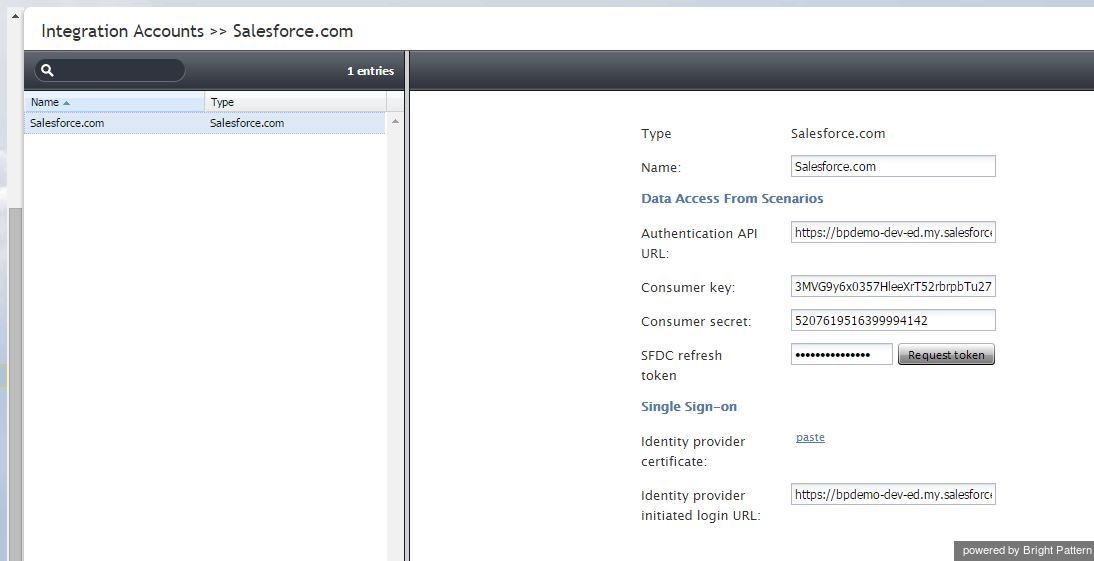Integration Accounts
Integration accounts specify parameters required for interoperability of your contact center solution with third-party systems, such as customer relationship management (CRM) integrations and workforce management applications (WFM).
To define, view, and edit integration accounts, select the Integration Accounts option from the Call Center Configuration menu.
The current version of the Bright Pattern Contact Center solution supports out-of-the-box integration with the following solutions:
- Zendesk customer relationship management application. The Zendesk integration scope includes integrated desktop, single sign-on, access to CRM data from scenarios, screen pop, activity history, and click-to-dial functions. For detailed integration instructions, including specification of the Zendesk integration account properties, see Zendesk Integration Guide. You can configure multiple Zendesk integration accounts for access to different Zendesk systems.
- RightNow (Oracle RightNow Dynamic Agent Desktop Cloud Service) customer relationship management applications. The integration scope includes integrated desktop, access to CRM data from scenarios, screen-pop, and activity history functions. For detailed integration instructions, including specification of the RightNow integration account properties, see RightNow Integration Guide. You can configure multiple RightNow integration accounts for access to different RightNow systems.
- Salesforce.com customer relationship management applications. The integration scope includes integrated desktop, single sign-on, access to CRM data from scenarios, screen pop, activity history, and click-to-dial functions. For detailed integration instructions, including specification of the Salesforce.com integration account properties, see Salesforce.com Integration Guide. You can also create calling lists using contact records imported from SFDC and export the corresponding campaign results directly to SFDC. Note that currently you can only have one Saleforce.com integration account in your contact center.
- Aspect WFM workforce management application. The integration scope includes a number of automatically generated reports for workforce scheduling and real-time monitoring of agents’ adherence to work schedules.
Version 1.1 and later of the Transport Layer Security (TLS) encryption protocol is used to ensure security of the data passed between Bright Pattern and the CRM applications.
The reports required for workforce scheduling are configured for automatic generation and delivery via the Scheduled Reports screen of the Contact Center Administrator application.
Aspect WFM Integration
Setup of the Aspect WFM integration account is only necessary if you plan to use Aspect WFM for real-time adherence monitoring. Typically in this case, the Universal interface of the Aspect Real-Time Adherence server (RTA) must be configured to be ready to receive a data feed. For more information, please refer to the Aspect Workforce Management 7.5 Installation Guide, chapter Configuring ACD Instances, section Universal ACD. Note that the Unicode checkbox of the Universal interface must be selected (the ASCII option is not supported).
Note that you can only have one Aspect WFM integration account in your contact center.
Aspect WFM Integration Account Screen Properties
The parameters that must be configured on the Bright Pattern side to enable the real-time adherence data feed are described as follows.
Name
The Name of the integration account must be unique.
Protocol
Protocol refers to the communication protocol, which is read-only Currently TCP is the only option.
Host name
Host name is the name or IP address of the host where the Aspect Real-Time Adherence server (RTA) is run.
Port
Port refers to the TCP port assigned to the Aspect RTA server on the above host. It must correspond to the port configured on the RTA side.
Periodic update interval
Periodic update interval is the period with which real-time metrics will be updated.
Record field sizes
Record field sizes is the property that specifies the lengths of the data fields communicated to Aspect RTA. The default values correspond to the default settings of the same fields on the RTA side. If values of these fields are changed on the RTA side, they must be changed accordingly in this property.

